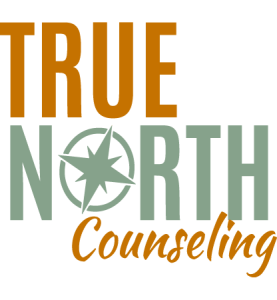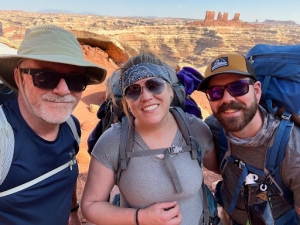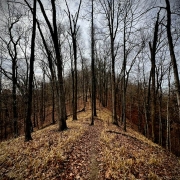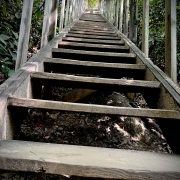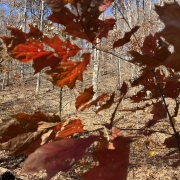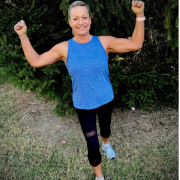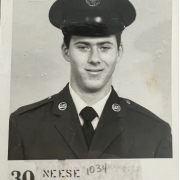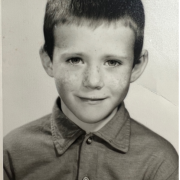Want to Break Up with Food? Learn to Hike!! | Healthy Aging Series: S9 E21
I was sitting in Terminal C at the Denver Airport gate 47 recently. I had a five-hour layover. Time to write and observe people. I’ve been noticing something concerning at airports with the past few years. I’ve noticed more and more people needing wheelchair assistance to get to their gates and to board. I researched it and here’s what I found.
First, let me say that many disabled travelers report nightmares when traveling via the airlines. The Department of Transportation cited a 108% increase in complaints from flyers with disabilities in a three-year period from 2019 to 2022. Complaints range from lost or damaged wheelchairs to embarrassment from poor transfers and even physical injury. Traveling with a disability that requires a wheelchair can be a horrific experience. Thankfully, the Air Carrier Access Act prohibits discrimination against persons with disabilities. I encourage you to read it and know your rights. It gives flyers with disabilities recourse if their rights are violated.
Second, I want to ask, “Why has there been an increase in wheelchair use?” Airlines do not keep statistics on wheelchair use, so here are my thoughts. People with physical disabilities and frail older adults are flying more to stay connected with people and places. Boomers are aging. Families are relocating away from their hometowns. Flying helps them stay connected. But, I also think there has been an increase in people with mobility issues that have resulted from being overweight or obese. Many of those seeking wheelchair assistance can walk short distances, but due to the loss of stability and mobility, they lack the muscle and aerobic endurance to walk through large airports. I don’t want to overgeneralize, and my heart breaks for people with severe mobility issues, but with my Personal Training background, and a specialization in senior fitness, I think it’s fair to make a few assumptions. The real question is, can mobility issues be prevented and improved upon in cases with adults suffering from obesity and physical disabilities? The answer is yes! Older adults can enlist the help of a professional to regain their mobility.
I recently read two articles in the New York Times that agree with this conclusion. The first article, “Just Two Minutes of Walking After a Meal is Surprisingly Good for You,” by Rachel Fairbank, looked at walking as a means of managing your blood glucose levels. “In a meta-analysis, recently published in the journal of sports medicine,“ she writes, “researchers looked at the results of seven studies that compare the effects of sitting versus standing or walking on measures of heart health, including insulin and blood sugar levels. They found that light walking after a meal, in increments of as little as 2 to 5 minutes, had a significant impact on moderating blood sugar levels.”
Managing blood glucose is extremely important as a means of reducing the risk of developing type two diabetes. Weight management is extremely important as we age. If we do nothing, it is possible to put on 2 to 3 pounds a year, amounting to 20 or 30 pounds over the period of a decade. We wake up and we’ve gained 30 pounds! It happens. If a 2-to-5-minute walk helps, think about how much more benefit at 20-to-30-minute walk after dinner.
When the weather permits, my wife and I do three laps in our neighborhood after dinner. That’s about 30 minutes and adds up to 1 mile or 1700 to 1800 steps. Without changing your diet, walking 10,000 steps burns 300 to 800 cal. That adds up to a pound a week. Just walking enhances your mobility.
The second article was about the benefits of hiking. In her article, “Hiking Has all the Benefits of Walking and More. Here’s How to Get Started,“ Danielle Friedman, writes “Hiking offers all the cardiovascular benefits of walking, but the uneven terrain does more to strengthen the legs and core muscles, which in turn, boosts balance and stability. It also burns more calories than walking.”
Because of my Personal Trainer background, I have encouraged aging adults to incorporate instability into their workouts. If you want to be more stable and less prone to falls, you need to activate muscles that do not get activated on even surfaces. I rarely train with trekking poles. I use them as handrails when I’m doing elevation in places like the Smoky Mountains, the Grand Canyon, or hiking in Colorado. Otherwise, I leave them home and allow the terrain to challenge my legs, knees, and ankles. Friedman offered some very good advice for getting started. I’ve got about 30 years of experience hiking, 20+ years of backpacking, and here’s my advice for getting more stable.
These are suggestions and not necessarily in order of importance. Just my random thoughts.
1. Find a park that has trails and maps of those trails. Louisville has lots and lots of parks with trails and maps as well. I hike in the Jefferson Memorial Forest and in the Parklands. Maps are available online or at the visitor center at the Jefferson Memorial Forest. Trail maps for Parklands are typically at the kiosks at the entrances of the park. There is the Bernheim Forest, KY and Hoosier National Forest in Indiana. There’s the Daniel Boone National Forest and the Red River Gorge in the eastern part of the state of Kentucky. I just Googled places to hike in Kentucky and many, many hits. There is no excuse not to hike in Kentucky.
2. Start easy and progress to harder trails. That means, starting with short trails and trails with less elevation. Trails are usually, but not always posted as easy, moderate, or difficult. I would suggest flat or no elevation trails that are 2 miles or less for your first hike. Move at a 30 minute per mile pace. You should finish in one hour.
3. Buy some gear. You’ll need a day pack and some water bottles. Shoes and socks. I always wear smart wool or acrylic socks, and I buy most of my shoes from Quest for the Outdoors. Don’t buy the most expensive shoes but don’t buy the cheapest shoes.
Take with you in your daypack:
- Ziploc baggies in case it rains
- Take an umbrella in case it rains
- You’ll need insect repellents, mostly for chiggers that you’ll need to put on your ankles
- You need a map.
- You’ll need clothing that is determined by the time of year. I buy most of all my clothing at Walmart, Target, and, at Meijer’s. It’s cheaper and good quality wicking material.
- I use a smart watch to track my hikes. I use a Fitbit because its app works better for me.
- I take a headlamp, especially if I’m going to be hiking in the evenings.
- Take some snacks, which typically consist of energy bars.
4. There are lots of hiking groups for hiking and a variety of experience within those groups, so you won’t feel uncomfortable or intimidated. I did a Google search of “hiking groups near me” and found nine groups with links to each group.
5. Get out and enjoy the trails. Hike for your mental and physical health. Some of my most relaxing and creative times have been on the trails. Learn to love the hills. If you hike in Kentucky or Southern Indiana, you will encounter hills. They are your friends. Hills are the HITT experience in the woods.
I am a very even-tempered person, but I find myself getting upset when the weather interferes with my hiking.
My wife is the same way with Jazzercise. Develop a love for hiking and it will keep you fit, stable, and out of the wheelchair.
To read more entries in the Healthy Aging series, click here.
